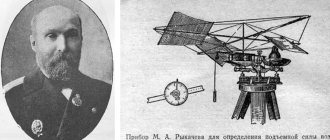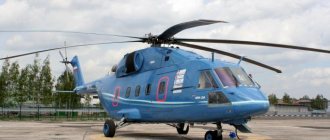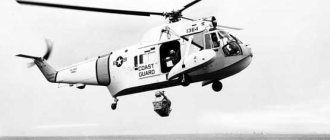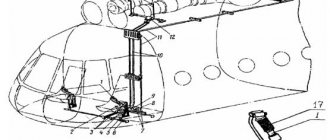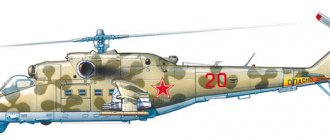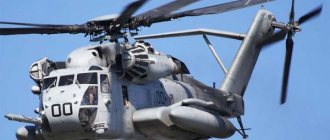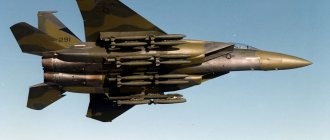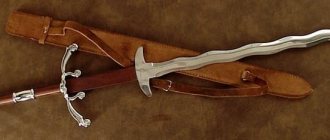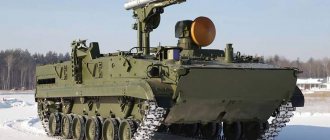The Mi-35 is a modernized version of the Mi-24 helicopter. This attack helicopter is produced both for the needs of the Russian Ministry of Defense and for export.
The main tasks assigned to this combat vehicle are:
- destruction of enemy armored vehicles;
- fire support for ground and airborne units;
- evacuation of the wounded and sick;
- transportation of goods in the cabin and using an external sling.
Features of the Mi-35
The development of this combat vehicle began in 1968, and its final appearance was formed only in 1973. At its core, the Mi-35 is an export version of the Mi-24 attack multi-purpose helicopter. From a constructive point of view, the great advantage of the helicopter was the unification of many of its components with those used in the Mi-8 and Mi-14.
The characteristics that the Mi-35 has fully justify the fact that it is often called a “flying infantry fighting vehicle.” The fact is that from the very beginning the crew was equipped with flight armored helmets and body armor, the cockpit windshield and crew seats were armored, local armor plates were installed on the engine hoods and on the sides of the cabin.
The stability of the helicopter at speeds exceeding 200 km/h is ensured by the fact that it was equipped with a wing with a negative sweep of -12°. To increase the efficiency of directional control, a pulling tail rotor is used. All this made it possible to increase the speed of the car to 300 km/h.
Flight performance and use in combat
The comparison table shows that, despite the heaviest weight in its class of helicopters, the Russian machine is second only to the Denel AH-2 in terms of range. But the South African car is limited to just 12 units, so it can't be considered a serious contender.
| Parameter | Mi-35M | Denel AH-2 | McDonnell AH-64D Apache |
| Manufacturer country | Russia | South Africa | USA |
| Length, mm | 17490 | 18730 | 17760 |
| Height, mm | 4160 | 5185 | 4660 |
| Main screw diameter, mm | 17200 | 15580 | 14630 |
| Tail rotor diameter, mm | 3840 | 6355 | 2790 |
| Weight limit, kg | 11500 | 8750 | 9525 |
| Power of the power plant at takeoff, hp | 2*2200 | 2*1845 | 2*1695 |
| Maximum speed, km/h | 300 | 309 | 365 |
| Combat radius, km | 550 | 704 | 482 |
| Ferry range, km | 1000 (with external tanks) | 1260 | 1899 |
| Ceiling, m | up to 5400 | up to 6100 | 4465 |
| Crew, people | 2 | 2 | 2 |
| Load capacity | 2400 kg or 8 people. | 2032 kg | 771 kg |
The AH-2 helicopters use a 20 mm cannon, which has a significant (700 rounds) ammunition load. The 30 mm M230 cannon used on the Apache also has an expanded (up to 1200 pieces) supply of cartridges. The Russian Mi-35 can contrast suspended containers with small arms with foreign analogues. The list of missile weapons on helicopters is similar, including unguided and guided missiles designed to combat ground targets.
Due to the small number of vehicles built, it is used to a limited extent in military conflicts. The first loss of a combat Mi-35M occurred due to insufficient qualifications of the crew and erroneous operation of the radar. In early autumn 2012, a helicopter crashed into a mountainside in Dagestan.
The first relatively combat experience in using equipment was patrolling the border zones of Russia and Ukraine, carried out during the annexation of Crimea. Mi-35M helicopters entered into real combat during the fight against Islamic terrorists in Iraq. In mid-2014, two vehicles were destroyed by ground fire, killing both crews.
Iraqi helicopter pilots have killed several dozen terrorists. The vehicles are used by the Russian Aerospace Forces in combat operations in Syria. To date, the loss of two Russian helicopters has been officially recognized.
The complex of improvements carried out allowed us to breathe life into the aging “Crocodile”.
In addition, the company continues to modernize its equipment. The downside is the meager funding and the simultaneous production of the Mi-28N helicopter, which requires resources for further development. Despite the difficulties, the plant team is bringing Mi-35 vehicles to new markets.
So, in 2022, Pakistan, Mali and Nigeria received the first cars. This year, deliveries of the Mi-35 to these countries will continue. In 2022, it is planned to transfer 12 combat helicopters to Uzbekistan. These facts indicate that Mil Design Bureau equipment continues to be in demand on the global arms market.
Helicopter armament
The armament equipped with the helicopter also fully justifies the title of a flying infantry fighting vehicle. In particular, from the very first days of its existence the following were installed on it:
- Phalanga-M missiles with a manual control system;
- machine gun mount NUV-1 with machine gun A - 12.7;
- beam holders for NUR or free-falling bombs.
Subsequently, the combat vehicle’s armament was improved due to the fact that the USPU-24 machine gun mount with a YakB-12.7 machine gun, which has a rate of fire of 4,500 rounds per minute, and the Phalanga-P missile system appeared on board.
Various modifications
The very first modification of the Mi-28A did not find its serial solution, since it did not meet the standards and norms of a helicopter operating around the clock. The Mi-28N, or “Night Hunter,” on the contrary, showed itself well and was put into mass production. Its difference was the installation of a more modified avionics. Missile guidance is carried out by the Tor complex, produced at the Krasnogorsk Plant named after Zverev OJSC. The lower hemisphere is surveyed by TOES521, and the updated OPS helps with night flights.
- Mi-28 is an experimental prototype. Coded as "product 280".
- Mi-28A - “product 286”. A modernized model with TV3-117 engines, fiberglass spars, equipment, and X-shaped RV 286-1.
- Mi-28L – licensed Mi-28A for use in Iraq.
- Mi-28N is a helicopter for night operations. Main gearbox VR-29.
- Mi-28NE – export version.
- Mi-28NM – modernized Mi-28N. Development is still underway.
- Mi-28UB - the helicopter is used for training purposes.
Design
The flight and combat characteristics of the helicopter are largely ensured by the successful formula used in its design. The Mi-35 was created in accordance with the classic single-rotor design, has a five-blade three-hinge main rotor and a three-blade tail rotor. The retractable landing gear consists of three legs, with the front leg being steerable.
The double cabin, intended for the crew, is made in tandem and is located in the bow of the vehicle. A separate front cabin is designed for the gunner-operator. The pilot's cabin, located in the background, is raised 0.3 m above the front cabin to ensure ease of viewing. The flight mechanic is located on a folding seat installed in the equipment compartment located behind the cockpit. Both crew cabins are sealed and have a heating and ventilation system. They maintain a low level of excess pressure, which prevents the entry of contaminated air in a combat situation.
The safety of the vehicle and personnel is ensured by armoring using steel plates:
- cockpits;
- drive boxes;
- engine oil tanks;
- gearboxes;
- hydraulic tank;
- the pilot's seat, which has a folding armored backrest and an armored headrest;
- partitions between cabins.
Moreover, the windshields are also armored, with windshield wipers installed to provide visibility.
The central part of the fuselage includes:
- a cargo compartment capable of accommodating eight paratroopers;
- the rear cone-shaped part, where the equipment and niches for cleaning the main landing gear are located.
To ensure stable speed and stability during forward motion, the rotor axis is simultaneously tilted 4.5° forward and 2.5° to the right.
History of the Mi-28
The helicopter was designed on a competitive basis. The Mi-28 was created by workers of the helicopter plant named after M.L. Mile. He was opposed by the Ka-50 (Kamov Design Bureau). The first prototype flew on November 10, 1982. It did not carry any weapons, since the first flight was made to test flight performance. It was installed only on the second copy. The design was adjusted to accommodate the comments made by the Air Force commission.
In 1985, construction began on the third prototype, in which all comments were taken into account. In 1987, the modernized model received the Mi-28A marking. Its tests began in January 1988, and after that the helicopter was demonstrated at air exhibitions in Paris and Red Hill (near London). In 1991, a second copy was created by employees of the cost center. Two years later, near Gorokhovets, he brilliantly demonstrated himself in exercises.
In 1996, on August 16, the helicopter underwent a modernization course (Mi-28N). Four months later he made his first test flight.
In 2005, GSI (state joint tests) began. The program included massive ground and air tests. They demonstrated the helicopter’s flight performance. They were led by the Commander-in-Chief of the Russian Air Force himself. In December, the company built the first prototype. The initial stage of the GSI ended in 2007.
State joint tests included two stages. The first described the overall picture and possible future production. In addition, the helicopter’s ability to destroy ground enemies was evident. The second stage tested the ability to hit airborne opponents using air-to-air missiles, as well as the survivability of the helicopter.
GSI for the Mi-28N ended on December 26, 2008. Based on the results, it became clear that the helicopter fully complies with the requirements and standards of technical specifications. In 2009, the President of the Russian Federation gave the order for the helicopter to be adopted by the Air Force, and in 2013 the same order was given by the country's Ministry of Defense. In 2005, a long-term agreement was signed for the supply of 67 Mi-28N units. At the same time, the head of the Russian General Staff, General Yu. Baluevsky, announced the need for special forces in the Ka-50 and Ka-52 helicopters, but clarified the information about the Mi-28N. "Night Hunter" is the main combat unit of the helicopter type.
In 2006, two copies took part in the Union Shield-2006 exercises on the territory of the Republic of Belarus. OP-1 (the first prototype) and 01-01 (the first pre-production model) were demonstrated. On September 7, state tests were carried out in Rostov-on-Don.
The first four Mi-28Ns were assigned to the Torzhok Combat Aviation Center (2008). In January of the same year, the first two copies arrived at the Torzhok Pulp and Paper Processing Plant and PLS AA. Between 2009 and 2011, the Russian Air Force received 27 production helicopters (the Fourth Army of the Air Force and Air Defense). By the end of 2010, the first helicopter squadron of sixteen production Mi-28Ns was formed at base 6971. In October, parallel deliveries of the helicopter to the 6974th air base began. By the end of 2010, the Russian Ministry of Defense received 38 production copies. After this, the Air Force and the plant entered into another contract for thirty helicopters. They had to be handed over before 2014. At the end of 2013, 63 Mi-28Ns were built for the Russian Air Force.
Instrumentation
The helicopter has modern instrumentation that increases the accuracy of the use of weapons installed on board and provides orientation for the crew.
In particular, round-the-clock detection and identification of objects at a distance exceeding 4 km is ensured using night vision devices, as well as an IRTV-44 MGH thermal imaging surveillance system. The accuracy of determining the current coordinates of the combat vehicle is guaranteed by the modern satellite navigation system GPS 115L GARMIN.
Thus, the Mi-35 helicopter is a well-armed and reliable combat vehicle capable of performing a variety of tasks in combat conditions.
Engine
The helicopter was equipped with modern VK-2500-02 engines, which are a further development of the TV3-117 line. These engines have increased parameters: power, altitude and service life. Thanks to this, the helicopter can be used effectively in high altitude conditions and elevated temperatures. In addition, if one of the motors breaks down, the power of the second will be enough for the helicopter to fly to the landing site and land safely. For this purpose, the corresponding engine operating modes are provided: “Emergency” and “Maximum”.
The motor turbine was built using modern heat-resistant materials. The disk of the 1st stage of the compressor has been strengthened. The motors are controlled by an electronic-mechanical system. By increasing the turbocharger speed, the pilot can safely increase the temperature of the gases.
Description
The Mi-35M multi-purpose attack helicopter is a deep modernization of the Mi-24V helicopter. The Mi-35M was developed by the Moscow Helicopter Plant named after M.L. Mile and has been mass-produced at Rostvertol since 2005.
The Mi-35M helicopter provides around the clock:
- combat use of helicopter guided and unguided weapons in simple and moderately difficult weather conditions;
- performing a flight at altitudes of 10–25 m during the day and at least 50 m at night above the earth’s surface with access to the target.
For round-the-clock combat use, the Mi-35M is equipped with a modern navigation and electronic display system with multifunctional color displays, a surveillance and sighting system that includes thermal imaging and television channels, a laser range finder and a direction finder.
The Mi-35M features an improved design. It is equipped with new powerful VK-2500 engines produced by Klimov, has fiberglass main rotor blades, a main rotor hub with elastomeric hinges, a new swashplate and an X-shaped tail rotor. The fuselage of the Mi-35M helicopter has a shortened wing and a fixed landing gear.
The Mi-35M is distinguished by high flight characteristics, in particular, it can be effectively used in conditions of high temperatures and high altitudes. The design of the Mi-35M provides the helicopter with low acoustic signature, increased combat survivability, and also reduces the labor intensity of maintenance.
In addition to performing strike functions, the Mi-35M helicopter can be used as:
- airborne transport - for transporting up to 8 paratroopers with personal weapons in the transport cabin;
- transport - for transporting ammunition or other cargo with a total weight of up to 1500 kg inside the cargo compartment. The Mi-35M is also equipped with an external suspension system that allows it to transport cargo weighing up to 2400 kg;
- sanitary - for transporting the sick and wounded, accompanied by a medical worker.
For many years, Mi-24/25/35 helicopters have proven their high efficiency. The Mi-35M is a machine in which the unique experience of long-term combat use is combined with the latest achievements and developments in the field of helicopter engineering.
History of creation and production
The Mi-26 heavy transport helicopter was developed by the Moscow Helicopter Plant named after. M.L. Mil (general designer M.N. Tishchenko, chief designer G.P. Smirnov, leading designer O.P. Bakhov) and was intended to replace the Mi-6 and Mi-10 helicopters.
The preliminary design was approved in December 1971, and the following year positive conclusions were received from relevant institutes and the Ministry of Defense. In 1972, a prototype of the Mi-26 was built, which was accepted by the State Commission in 1975. By that time, most of the design work had been completed, and V.V. became the new leading designer. Shutov.
The first flight prototype of the Mi-26 left the assembly shop (Panki) in October 1977, and on December 14 of the same year it took off under the control of a crew led by leading test pilot G.R. Karapetyan. In February 1978, the helicopter flew to the flight test base in Lyubertsy, where its factory tests began. Joint State tests of two Mi-26s took place at the Air Force Research Institute from May 1979 to August 1980. During the tests, both helicopters performed 150 flights with a total duration of 104 hours. As a result, recommendations were received for launching the Mi-26 into mass production and accepting it into service with the Soviet Army.
Serial production of the Mi-26 was organized at the Rostov Helicopter Plant (JSC Rostvertol), the D-136 engine at the Zaporozhye Production Association Motorostroitel (today JSC Motor Sich, chief designer F.M. Muravchenko).
Adopted by the Air Force in 1985, 276 vehicles were produced until 1997.
In October 1980, testing of the first Mi-26 (No. 01-01) began. Serial production of Mi-26 helicopters began in 1984; in total, more than 300 helicopters for civil and military purposes were built. The first series consisted of three (No. 01-01 - 01-03), the second - five (No. 02-01 - 02-05) cars. Further production took place in series of ten cars. One helicopter (No. 04 -10A) was transferred to TsAGI in 1985 for static tests. 40 helicopters were exported to various countries (including 12 to Canada and 10 to India).


